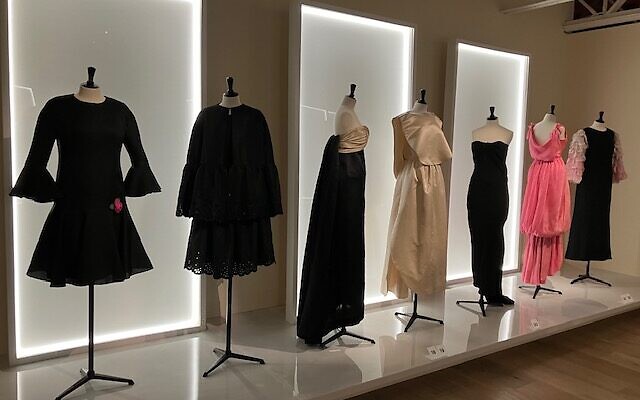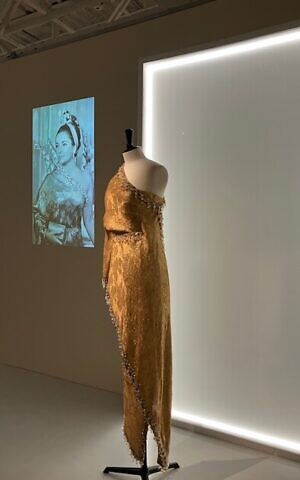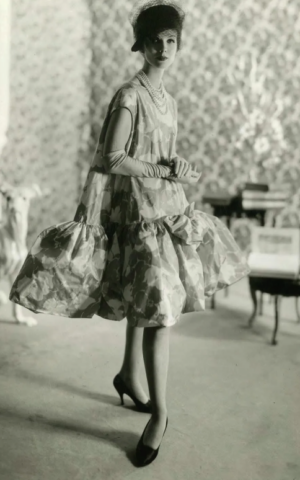SCAD Show Features Controversial Designer
Both the Spanish born designer Balenciaga and the French Coco Chanel were Nazi favorites.

Cristobal Balenciaga was only 11 when he started helping his mother, a local seamstress, in the summer resort town of Getaria in the Basque country of northern Spain. One of her clients was a rich member of Spain’s nobility who took a liking to the young boy and helped him learn the intricacies of designing women’s clothing. The next year, he made her a dress and his career as one of the greatest couturiers of women’s clothing was launched.
Before he retired in Paris 58 years later, he had dressed some of the most important women of the 20th century. Now the SCAD Museum, which was created by the Savannah College of Art and Design on its campus in Midtown, recalls that era in an exhibit entitled simply, “Cristobal Balenciaga Master of Tailoring.”

The exhibition, which was created with the help of the Azzadin Alaīa Foundation, shows off a carefully curated selection of his designs from the late 1930s to the late 1960s.
Balenciaga first became widely known when he set up his elegant salon at 10 Avenue George V where the clothes were always the star. Balenciaga shunned the press and did only one interview in his long career, but he created a long line of reverent clients known as “Balenciagas” who fell in love with his designs that often combined simplicity with an extraordinary fashion sense.
Hollywood stars Elizabeth Taylor and Grace Kelly wore his clothing as did many of the wealthiest and socially prominent women of the time. The American heiress Barbara Hutton and the wife of the very rich American banker Paul Mellon were longtime customers.
Bunny Mellon had four copies made of every design she bought from him. When she looked in her closets at each of the four homes she and her husband owned, the Balenciagas would always be there to wear.
She lived to be 104 and before she died, she gave a collection of 660 of her most cherished dresses, coats, and gowns to the impressive museum that was started in his hometown. She had the sketches for many of her clothes bound in a leather book with gold lettering on the cover that read, simply, “I feel pretty.”
But for all the reverential hero worship that followed Balenciaga through the war years, there was a darker side to his success that the SCAD exhibit barely mentions. During the war years when many designers had to close their salons because of a shortage of fabrics and other materials, Balenciaga thrived.

He was a favorite of the Spanish fascist dictator, Generalissimo Francisco Franco of Spain, who had come to power after the Spanish Civil War with the decisive support of another fascist, Adolf Hitler.
Hitler adapted many of the advances in warfare that he used in supporting Franco in his “Blitzkrieg,” or Lightening War, across much of Europe. Hitler was such an admirer of the Spanish born designer that he tried unsuccessfully to move him to Berlin in the 1940s.
While an estimated 77,000 Jews were being rounded up to be sent to their deaths in Auschwitz, the couturier was creating his silk ball gowns for Nazi dignitaries.
But Balenciaga wasn’t the only Parisian designer during the war who befriended the Nazis. During their occupation of the French capital from 1940 to 1944, a favored designer was Coco Chanel who cozied up to the Germans and profited from it.
She took as her lover a Nazi intelligence officer, Günther von Dinklage. They lived together in the Hotel Ritz in Paris, which was the Nazi headquarters there. In 1941, she even became an intelligence officer herself, Agent F-7124, with the code name, Westminster.

According to “Sleeping With the Enemy,” by author Hal Vaughn, one of the primary reasons she curried favor with the Germans was to regain control of her profitable perfume business, Chanel No. 5, that she had sold off to the Jewish Wertheimer family in 1924.
But Wertheimer was one step ahead of her, and before she could act he sold the business to a non-Jew, and fled to the United States. She talked her way out of trouble after the war and picked up her life as a fashion icon who lived out her final years in the same Hotel Ritz that she had enjoyed with her Nazi boyfriend.
As his final design job, Balenciaga came out of retirement to design the white satin wedding dress for Franco’s granddaughter when she married into the Spanish royal family in 1972.
- Arts and Culture
- fashion
- Bob Bahr
- Cristóbal Balenciaga
- Savannah College of Art and Design
- Azzadin Alaīa Foundation
- Elizabeth Taylor and Grace Kelly
- Barbara Hutton
- Paul Mellon
- Bunny Mellon
- Generalissimo Francisco Franco
- Spanish Civil War
- Adolf Hitler
- Coco Chanel
- Günther von Dinklage
- Agent F-7124
- Hal Vaughn



comments